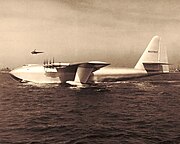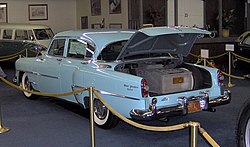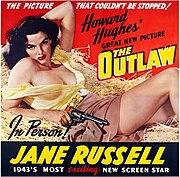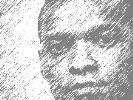The wealthy and aging Howard Hughes, accompanied by his entourage of personal aides, moved from one hotel to another, always taking up residence in the top floor penthouse. During the last ten years of his life, from 1966 to 1976, Hughes lived in hotels in Beverly Hills; Boston; Las Vegas; Nassau, Bahamas; Vancouver, Canada;[20] London, England; Managua, Nicaragua; Acapulco, Mexico; and others. One of the reasons he moved so many times was because of his obsession with minimizing taxation. Anyone who inhabits a state for six months out of the year must pay state income tax. To avoid this, Howard would move every five and a half months thus claiming no legal state residence.
On 27 November 1966, Hughes arrived in Las Vegas by railroad car and moved into the Desert Inn. Refusing to leave the hotel and to avoid further conflicts with the owners of the hotel, Hughes bought the Desert Inn in early 1967. The hotel's eighth floor became the nerve center of his empire and the ninth-floor penthouse became Hughes' personal residence. Between 1966 and 1968, Hughes bought several other hotels/casinos (Castaways, New Frontier, The Landmark Hotel and Casino, Sands, and Silver Slipper) from the Mafia. An unusual incident marked an earlier Hughes connection to Las Vegas. During his 1944 engagement at the Last Frontier hotel in Las Vegas, flamboyant entertainer Liberace mistakingly took Howard Hughes for his light director, instructing him to instantly bring up a blue light should he start to play "Claire De Lune." The alleged staff member nodded in accordance as the hotel's entertainment director approached the scene, properly introducing Howard Hughes to Liberace.[21]
Hughes wanted to change the image of Las Vegas from its mobsters in gaudy silk suits and thousand-dollar-a-night call girls to something more glamorous. As Hughes wrote in a memo to an aide, "I like to think of Las Vegas in terms of a well-dressed man in a dinner jacket and a beautifully jeweled and furred female getting out of an expensive car." A chronic insomniac, Hughes bought several local television stations (including KLAS-TV) so that there would always be something for him to watch in the early hours of the morning.
Hughes' considerable business holdings were overseen by a small panel unofficially dubbed "The Mormon Mafia" because of the many Latter-day Saints on the committee.[22] In addition to supervising day-to-day business operations and Hughes' health, they also went to great pains to satisfy Hughes' every whim. Hughes once became fond of Baskin-Robbins' Banana Nut ice cream so his aides sought to secure a bulk shipment for him—only to discover that Baskin-Robbins had discontinued the flavor. They put in a request for the smallest amount the company could provide for a special order, 350 gallons (1,300 L), and had it shipped from Los Angeles to Las Vegas. A few days after the order arrived, Hughes announced he was tired of Banana Nut and wanted only French Vanilla ice cream. The Desert Inn ended up distributing free Banana Nut ice cream to casino customers for a year, until the 350 gallons were gone.[23]
As an owner of several major businesses in Las Vegas, Hughes wielded enormous political and economic power in Nevada and was often able to influence the outcome of elections there and elsewhere. A marked obsession that affected Hughes throughout the late 1960s and early 1970s was the underground nuclear testing that was then occurring in Nevada. Hughes was afraid of the risk posed by the residual nuclear radiation from the tests. Hughes stayed up for days and nights on end, managing his assets to try to halt the nuclear tests. When they finally went through despite Hughes' efforts, the detonations were powerful enough that the entire hotel in which he was staying trembled with the shock wave. In two separate, last-ditch maneuvers, Hughes instructed his representatives to offer million-dollar bribes to both presidents Lyndon B. Johnson and Richard Nixon. His aides never offered the bribes, reporting to Hughes that Johnson declined the offer and they were unable to contact Nixon. Hughes' personal correspondence makes it clear that the Nevada nuclear testing issue was the last straw leading to his self-imposed exile from the United States, which was to end only with his death.
In 1971, Jean Peters filed for divorce; the two had not lived together for many years. Peters requested a lifetime alimony payment of $70,000 a year, adjusted for inflation, and waived all claims to Hughes' estate. Hughes offered her a settlement of over a million dollars, but she declined it. Hughes did not insist upon a confidentiality agreement from Peters as a condition of the divorce; aides reported that Hughes never spoke ill of her. She refused to discuss her life with Hughes and declined several lucrative offers from big-name publishers and biographers. Peters would state only that she had not seen Hughes for several years before their divorce, because his psychological problems forced him to stay in a separate room, talking with her only by phone.
Hughes was living in the Intercontinental Hotel near Lake Managua in Nicaragua where he sought privacy and security.[24] However, a powerful 6.5 earthquake damaged Managua in December 1972. On the pretext of possible assassination and intrusive press photographers, his aides insisted the windows be blacked out. He took precautions and stayed in the Nicaraguan National Palace with former dictator Anastasio Somoza Debayle before leaving for Florida on a private jet the following day.[25]
In 1972, author Clifford Irving created a media sensation when he claimed to have co-written an authorized autobiography of Hughes. Hughes was such a reclusive figure that he did not immediately publicly refute Irving's statement, leading many people to believe Irving's book was a genuine autobiography. Before the book's publication, however, Hughes finally denounced Irving in a teleconference and the entire project was eventually exposed as a hoax. Irving was later convicted of fraud and spent 17 months in prison. The 2007 film The Hoax, starring Richard Gere, is based on these events.










